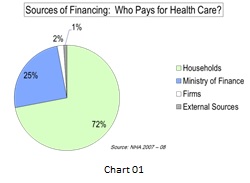Egypt moving toward integrated healthcare system

Islam Anan of Kantar Health explores the healthcare system in Egypt in pharmaphorum's emerging markets themed month.
 For decades Egypt has been trying to reach a high level of healthcare insurance coverage. However, it still has the highest out-of-pocket expenditure in the Middle East and North Africa, representing up to 72% of total healthcare spending (chart 1).
For decades Egypt has been trying to reach a high level of healthcare insurance coverage. However, it still has the highest out-of-pocket expenditure in the Middle East and North Africa, representing up to 72% of total healthcare spending (chart 1).
Egypt's Ministry of Health (MoH) covers 17% of the population,1 and the Health Insurance Organization (HIO) covers 58.2% of Egyptians.2 However, only 6% of Egyptians actually use HIO services1 because coverage was not satisfactory. The MoH has put forward a plan for a new HIO system that would cover 70% of Egyptians by 2016, with the private sector contributing 20% of coverage at a cost of 16 Billion EGP.3
To extend the reach of healthcare coverage and avoid wasting budget and time, Egypt's two main payers will work together to launch one integrated payer system. In the new system, the HIO will be the budget holder only and the MoH will be the service provider. Some logistical progress was made, but not enough to launch the idea nationally.
Pharmaceutical companies also play a role in this integrated system. Led by Dr. Sherif Abaza (Market Access Head – Egypt), Roche took the initiative by helping the two payer systems put the integration plan together. Kantar Health worked with Roche to present orientation sessions to HIO and MoH department heads on what is meant by "integrated healthcare system."
Examples were shown from countries that have universal healthcare coverage, and the importance of building health technology assessment (HTA) as the audit and system core for new interventions and technologies assessment was discussed, followed by building a taskforce team putting the reform standard operating procedure to improve the process, and a cycle of meetings to track progress every three months.
"For decades Egypt has been trying to reach a high level of healthcare insurance coverage."
To set a detailed objective for the new reform, a closer look at global healthcare systems and objectives should be considered. The main objective for any healthcare system can be summarized as:
1. Access: Achieve the broadest reach with ease access of patients to the service providers
2. Best Quality: Provide the population with the best quality service and the newest healthcare technologies
3. Cost: Use the budget with the ultimate return and provide services with the lowest costs
4. Differential: Be different and unique from other countries
5. Effectiveness: Determine the correct assessment of services and system efficiency
The first and most important aspect to concentrate on in healthcare system reform is investing in informatics infrastructure (data, knowledge, services) to build a beneficiaries database (registries and patients charts). This will help in managing treatment protocols as well as getting correct forecasts for services and treatments purchase. The MoH has already started this process by initiating a supply chain project.
Along with the informatics infrastructure development, quality aspects also should be considered:
• Enhancing patient safety by reducing medication errors
• Enhancing uniformly high quality by measuring performance to benchmark for select inpatient and outpatient conditions
• Expanding disease management programs by supporting activities for certain patients with chronic illnesses
• Improving cost effectiveness through managing utilization trends and analysis of variance
Healthcare systems worldwide can be categorized by four types:
1. Traditional sickness insurance: Fundamentally a private insurance market approach with state support (e.g., Germany)
2. National health insurance: National-level health insurance system (e.g., Canada, Finland, Norway, Spain and Sweden)
3. National health services: State provides the healthcare (e.g., Denmark, Greece, Italy, New Zealand, Portugal, Turkey and the United Kingdom)
4. Mixed systems: Contain elements of both traditional sickness insurance and national health coverage (e.g., Switzerland and the United States)
Although Egypt started as a national health service back in the 1950s, it now is considered a mixed system.
All of the above-mentioned systems have their strengths and limitations. For example, some have a long wait list (1 million citizens in UK) caused by the limited number of specialized physicians available. Rapidly aging populations are causing a demographic change that will place severe pressure on social security and healthcare programs. High-tech medicines are overemphasized at the expense of preventive and long-term care. High unemployment rates have narrowed the base for payroll contributions to the funds (as in Germany).
"Healthcare systems worldwide can be categorized by four types..."
All the above limitations have forced countries to seek solutions, such as finding new sources of tax revenue, imposing more stringent fee and budgetary controls on health providers, finding ways to increase efficiency in health care delivery, scale back on benefits by no longer insuring some previously covered services, and impose user fees.
Although many of the above mentioned solutions were applied in several countries especially after the financial crises and recessions in the last decade, the problem will be mainly in system efficiency and decreased budget waste before asking for more revenues. Many government officials see that the budget issue in Egypt is somehow overrated and the solution won't be increasing budget but first better allocation and utilization of the available budget, the reasons moved many countries toward HTA bodies, which can manage the scrutiny of budget and offer the most cost-effective services (interventions / medications) that meet the country's budget.
In conclusion, HTA bodies working with the HIO will be the key to reach better efficiency in healthcare services. The HTA is planned to be launched by end of 2014 in Egypt and will be a strong asset in the new HIO Egyptian system.
References
1. NHA (National Health Accounts) 2008/2009 report
2. HIO official site http://www.hio.gov.eg/Ar/covers/Pages/Charts4.aspx
3. http://www.misrday.com/news-misr-day/1055196.html
About the author:
Islam Anan Bsc. Ph. Sc.
Director, Business Development (Egypt and North Africa) Kantar Health, Cairo.
Have your say: What will Egypt's healthcare system look like in two years' time?












